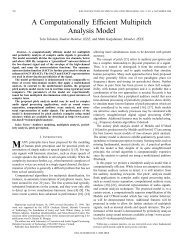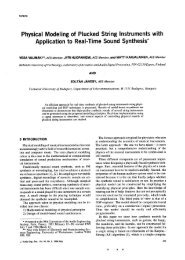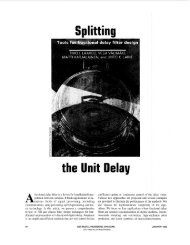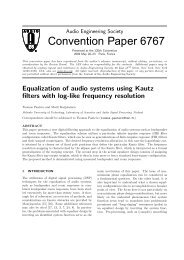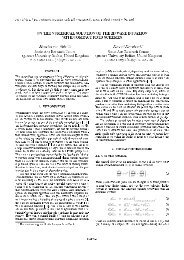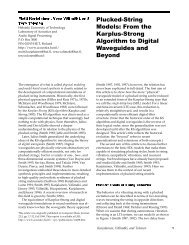Evaluation of learning in computer based education using log ...
Evaluation of learning in computer based education using log ...
Evaluation of learning in computer based education using log ...
- No tags were found...
Create successful ePaper yourself
Turn your PDF publications into a flip-book with our unique Google optimized e-Paper software.
Session 12a3Server I ClimtIIIIest <strong>in</strong> <strong>learn<strong>in</strong>g</strong> evaluation. Naturally, these would be casedependentparameters and certa<strong>in</strong>ly <strong>in</strong>orc difficult to implcment.Besides cvaluation <strong>of</strong> <strong>learn<strong>in</strong>g</strong>, <strong>log</strong>g<strong>in</strong>g is R very usefulconcept <strong>in</strong> other related areas as well. An example could bcpsycho<strong>log</strong>ical test<strong>in</strong>g, where it is sometimes cven mare i<strong>in</strong>portantto know how a person takes the test than whai hdsheanswered. Creat<strong>in</strong>g such test <strong>in</strong> an electronic form ratherthan traditional paper version, and <strong>in</strong>clud<strong>in</strong>g <strong>log</strong>g<strong>in</strong>g <strong>in</strong> thesyslem, would result <strong>in</strong> an cxtended set <strong>of</strong> material and, perhaps,<strong>in</strong>creased accuracy for psycho<strong>log</strong>ical evaluation.12. REFERENCESFigure 1: An advanced WWW architectureIn this structure, a User Agent represents the real user andtakes carc <strong>of</strong> all the requests made to thc server. It respondsto these requests with appropriate data accord<strong>in</strong>g to spccihcations made by the developer. Thus itrepresents the teacherits well and the nppropriate term <strong>in</strong> this case would be n DUMbleAgeng.There are a numbcr <strong>of</strong> ways to implement such architecture,but these are very sophisticated and far beyond thescope <strong>of</strong> this paper. In pr<strong>in</strong>ciplc, this type <strong>of</strong> structure allows<strong>log</strong>g<strong>in</strong>g to be applied <strong>in</strong> both <strong>of</strong>f-l<strong>in</strong>e evaluation and on-l<strong>in</strong>e<strong>in</strong>teractive control.13. CONCLUSIONSCompared to traditional methods, <strong>log</strong>-<strong>based</strong> evaluntion hascerta<strong>in</strong> advantages. Particularly, <strong>log</strong>s will <strong>in</strong>clude real <strong>in</strong>formation<strong>of</strong> the <strong>learn<strong>in</strong>g</strong> p~~occss itself, which is quite impossibleto expose with traditional methods like written exam<strong>in</strong>ationsnr assessment forms. The concept <strong>of</strong> <strong>log</strong>g<strong>in</strong>g alsosupports the cugnifive-conslr!tctive theory <strong>of</strong> <strong>learn<strong>in</strong>g</strong> I cl],prnvided that the CBE material itself was constructed <strong>in</strong> thismanner.Logg<strong>in</strong>g also adds ncw possibilities io student selfevaluation,which <strong>in</strong> university lcvel studies and studentorientedlearniiig is very importnnt. Furthermorc, <strong>log</strong>-<strong>based</strong>evaluation <strong>in</strong>cludes a strong dependency un the contents,same as cxam<strong>in</strong>ations and Fccdback forms. When used <strong>in</strong>comb<strong>in</strong>ation with cxam<strong>in</strong>ntions or fecdback forms, <strong>log</strong>g<strong>in</strong>gcan, however, provide a more accurate evaluation OF <strong>learn<strong>in</strong>g</strong>.Furlhermore, <strong>log</strong>g<strong>in</strong>gdoes not havc to be restrictcd to userand transaction relatcd data but morc content orientcd parameterscould be used as well. For example content descript<strong>in</strong>nsor content lcvcl would be parameters <strong>of</strong> <strong>in</strong>ter-[I] Karjala<strong>in</strong>en M., Rahkila M., “Learn<strong>in</strong>g signal process<strong>in</strong>gconcepts and psychoacoustics <strong>in</strong> the QuickSig DSPenvironment”, <strong>in</strong> Pmc. 1995 ?EEE Irrt. Con$ Acoust.,Speech, nnd Proc. (ICASSP’H), Detroit, Michigan,USA, vol2, pp. 1125-1128, May 9-12,1995.http://www.acoustics.hut.fi/”mara/publica~ions/icassp95/[2] Wiezel, A., “Measur<strong>in</strong>g thc success <strong>of</strong> virtual tutor<strong>in</strong>g”,<strong>in</strong> Proc. 1998 IEEE Frontiers <strong>in</strong> Education(FIE’98), Tempo, Arizona, USA, Nov 12-15,1978.http://€airway.ecn.purdue.edu/-€ie/~ieg~/papera/l357.pdf[3] Rahkila M., Karjala<strong>in</strong>en M., “An Experimental Architecturefor Interactive Web-<strong>based</strong> DSP <strong>education</strong>,” <strong>in</strong>Proc. I998 IEEE hit. Cot$ Acotrst., Speech, and Six.Proc. (ICASSP’98). Seattle, Wash<strong>in</strong>gton, USA, May12-15,1998. pp. 1857-1860,http://www.acoust;ics,hut.fi/-mara/publications/icasspga/[4] Field<strong>in</strong>g, R., et al., “Hypertcxt Transfer Protocol -HTTP/1.1”, RFC 2068, January 1997.ftp://ftp.isi.edu/<strong>in</strong>-notes/rfc206E.txt[5] Kristol, D., Mnntulli, L., “HTTF Statc ManagementMechanism”, EFC 2109, February 1997.ftp://ftp.isi.edu/<strong>in</strong>-notes/rfc2109.txt[6] Bruner, 1. S., “Tnwrrd n Theory <strong>of</strong> Instruction”, IhrvardUniversity Press, Cambridge, MA, USA, 1966.November 10 - 13,1999 San Juan, Puerto Rico29th ASEEIIKEE Frontiers <strong>in</strong> Education Conferencc12n3-21






